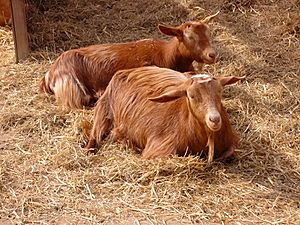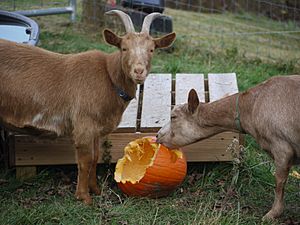Golden Guernsey facts for kids
 |
|
| Conservation status |
|
|---|---|
| Country of origin | Channel Islands |
| Distribution |
|
| Use | goat's milk |
| Traits | |
| Skin colour | golden |
| Wool colour | golden, from pale to reddish-brown |
| Horn status | usually polled (hornless) |
| Tassels | no |
|
|
The Golden Guernsey is a special and rare type of dairy goat. These goats come from Guernsey, one of the Channel Islands. People have known about these beautiful golden goats for over 200 years!
Contents
The Story of the Golden Guernsey
Golden-colored goats have lived in Guernsey for a very long time. The first time anyone wrote about them was in a travel guide from 1826. In the 1800s, these goats were sometimes called "Golden Gessenay." This name came from the Saanen breed, which is a Swiss goat.
During World War II, Guernsey was taken over by German forces. A brave woman named Miriam Milbourne risked her own safety to save these goats. She hid a small group of Golden Guernsey goats for several years. Thanks to her, the breed survived!
In 1965, some Golden Guernsey goats were brought to Great Britain. People who loved these goats formed a group called the English Golden Guernsey Club. This group later became the Golden Guernsey Goat Society.
Are Golden Guernseys Endangered?
Yes, the Golden Guernsey is considered an endangered breed. This means there are not many of them left. In 2007, a group called the FAO said they were "endangered-maintained." This means they are at risk, but people are working to keep them safe.
In 2019, there were about 1,381 Golden Guernseys reported. Another similar group, the British Guernsey, had about 171 goats. Both were listed as "at risk." The Rare Breeds Survival Trust also listed the Golden Guernsey as "minority" in 2020. This shows how important it is to protect these unique animals.
What Makes Them Special?
As their name suggests, Golden Guernsey goats have a beautiful golden color. Their coats can be light blond or a deep bronze. They are smaller and have finer bones than many other British milking goats. Their fur can also be different lengths.
Most male Golden Guernseys have impressive horns. It's very rare to find one without horns. For example, in one herd, almost all the baby goats born had horns. These goats are also known for being very calm and friendly. They make great companions!
Milk Production
Even though they are small, Golden Guernsey goats are good at producing milk. On average, a Golden Guernsey can give about 3.16 kilograms of milk each day. This is a bit less than some larger Swiss goats.
However, their milk is very rich! It has a high amount of butterfat (about 3.72%) and protein (about 2.81%). This makes their milk great for drinking or making cheese. Sometimes, a female goat (called a nanny) will start producing milk even without having a baby. This is called being a "maiden milker." One herd reported that their nannies produced about 4 to 5 pints of milk daily. This is for goats that eat grass and some extra food.


